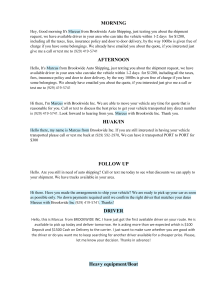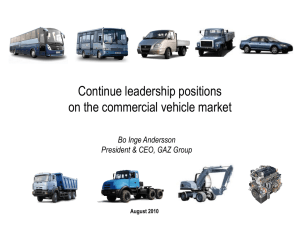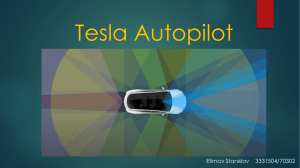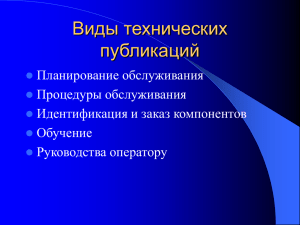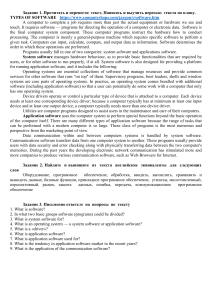Hum Ftrs Erg Mfg Svc - 2020 - Stanton - Turing in the driver s seat Can people distinguish between automated and
реклама
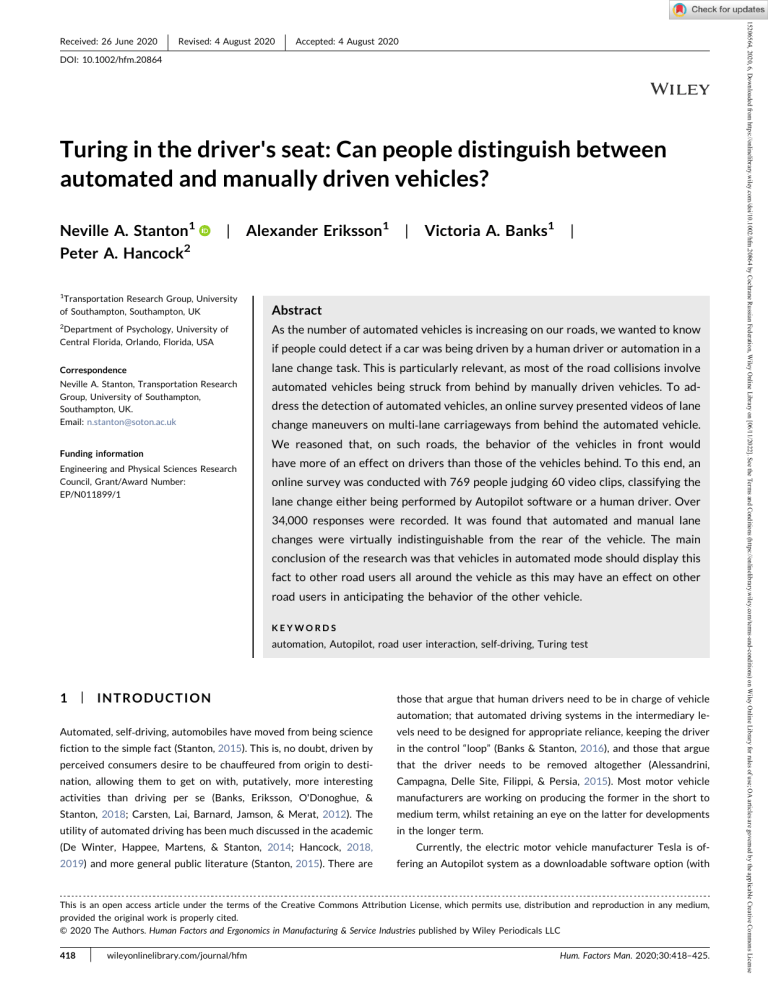
| Revised: 4 August 2020 | Accepted: 4 August 2020 DOI: 10.1002/hfm.20864 Turing in the driver's seat: Can people distinguish between automated and manually driven vehicles? Neville A. Stanton1 Peter A. Hancock2 | Alexander Eriksson1 | Victoria A. Banks1 1 Transportation Research Group, University of Southampton, Southampton, UK 2 | Abstract Department of Psychology, University of Central Florida, Orlando, Florida, USA As the number of automated vehicles is increasing on our roads, we wanted to know Correspondence lane change task. This is particularly relevant, as most of the road collisions involve Neville A. Stanton, Transportation Research Group, University of Southampton, Southampton, UK. Email: [email protected] automated vehicles being struck from behind by manually driven vehicles. To ad- if people could detect if a car was being driven by a human driver or automation in a dress the detection of automated vehicles, an online survey presented videos of lane change maneuvers on multi‐lane carriageways from behind the automated vehicle. We reasoned that, on such roads, the behavior of the vehicles in front would Funding information Engineering and Physical Sciences Research Council, Grant/Award Number: EP/N011899/1 have more of an effect on drivers than those of the vehicles behind. To this end, an online survey was conducted with 769 people judging 60 video clips, classifying the lane change either being performed by Autopilot software or a human driver. Over 34,000 responses were recorded. It was found that automated and manual lane changes were virtually indistinguishable from the rear of the vehicle. The main conclusion of the research was that vehicles in automated mode should display this fact to other road users all around the vehicle as this may have an effect on other road users in anticipating the behavior of the other vehicle. KEYWORDS automation, Autopilot, road user interaction, self‐driving, Turing test 1 | INTRODUCTION those that argue that human drivers need to be in charge of vehicle automation; that automated driving systems in the intermediary le- Automated, self‐driving, automobiles have moved from being science vels need to be designed for appropriate reliance, keeping the driver fiction to the simple fact (Stanton, 2015). This is, no doubt, driven by in the control “loop” (Banks & Stanton, 2016), and those that argue perceived consumers desire to be chauffeured from origin to desti- that the driver needs to be removed altogether (Alessandrini, nation, allowing them to get on with, putatively, more interesting Campagna, Delle Site, Filippi, & Persia, 2015). Most motor vehicle activities than driving per se (Banks, Eriksson, O'Donoghue, & manufacturers are working on producing the former in the short to Stanton, 2018; Carsten, Lai, Barnard, Jamson, & Merat, 2012). The medium term, whilst retaining an eye on the latter for developments utility of automated driving has been much discussed in the academic in the longer term. (De Winter, Happee, Martens, & Stanton, 2014; Hancock, 2018, Currently, the electric motor vehicle manufacturer Tesla is of- 2019) and more general public literature (Stanton, 2015). There are fering an Autopilot system as a downloadable software option (with This is an open access article under the terms of the Creative Commons Attribution License, which permits use, distribution and reproduction in any medium, provided the original work is properly cited. © 2020 The Authors. Human Factors and Ergonomics in Manufacturing & Service Industries published by Wiley Periodicals LLC 418 | wileyonlinelibrary.com/journal/hfm Hum. Factors Man. 2020;30:418–425. 15206564, 2020, 6, Downloaded from https://onlinelibrary.wiley.com/doi/10.1002/hfm.20864 by Cochrane Russian Federation, Wiley Online Library on [06/11/2022]. See the Terms and Conditions (https://onlinelibrary.wiley.com/terms-and-conditions) on Wiley Online Library for rules of use; OA articles are governed by the applicable Creative Commons License Received: 26 June 2020 | ET AL. 419 the promise of regular updates) when customers buy their cars. This Rodríguez (2017) found that cyclists feel less safe when interacting software claims to steer within a lane, change lanes with the simple with pod‐like automated vehicles in intersections. Thompson et al. tap of a turn signal, and manage speed by using active, traffic‐aware, (2020) suggest that automated vehicles could create conflicts with cruise control (Tesla Motors, 2016). Driving is, however, in fact, a other road users, particularly with cyclists and pedestrians. One way very demanding activity, comprising over 1600 subtasks (Walker, of resolving this was proposed via “the smiling car” (Semcon, 2017), Stanton, & Salmon, 2015). Learning to drive is effortful and takes which shows a pedestrian that they have been detected, and that the some considerable amount of time to master successfully (Stanton, vehicle will yield through a means of “humanlike” communication, Walker, Young, Kazi, & Salmon, 2007). Currently, over 1.35 million something that has been previously suggested by Eriksson and people a year die in traffic collisions around the world (World Health Stanton (2017a) and Norman (1993). Organization, 2018). Furthermore, it has been suggested that drivers The question remains, however, are human road users able to blamed for over 90% of collisions, whether it is their fault or not detect a vehicle being driven by a set of computer algorithms rather (Singh, 2015; Stanton & Salmon, 2009; Thorpe, Jochem, & than by another human driver in moving traffic? Whilst for some Pomerleau, 1997). Automated driving holds the potential to reduce vehicles, this differentiation is relatively simple (e.g., Waymo ve- this figure substantially (Musk, 2016; Stanton & Marsden, 1996). hicles, previously known as Google Car, are equipped with a large Elon Musk (Musk, 2016) has gone so far to say: “The probability of LIDAR scanner on the roof of the vehicle), vehicles equipped with having an accident is 50% lower if you have Autopilot on. Even with our automated functionality enabling periods of “hands and feet free first version. So we can see basically what's the average number of kilo- driving” (Banks, Stanton, & Harvey, 2014) are increasingly resem- meters to an accident – accident defined by airbag deployment. Even with bling normal cars. The Tesla Model S, for example, looks like any this early version, it's almost twice as good as a person.” Whilst this claim other medium‐sized saloon vehicle. Even if the driver following an is not based on any scientific studies, driver assistance systems could automated vehicle recognizes it as such (from the vehicle shape not only save many hundreds of thousands of lives worldwide but and/or badge), it does not necessarily mean that it is being driven in also would have helped the European Commission reach its goal of automated mode. This adds an additional layer of complexity to the reducing road traffic deaths by 50% by 2030 (European Commission, driving task (Walker, Stanton, & Salmon, 2018) as road users will not 2019). It must be noted that consumer adoption of automated ve- be able to distinguish what is an automated vehicle simply from the hicles cannot happen overnight even if this was desired. Con- make and model. The concern here is that automated and manual sequentially, a transition period must be expected in which driving might be quite different in terms of setting appropriate ex- automated and manually driven vehicles share the same infra- pectations about their future behavior for drivers of manually drive structure (Ioannou, 1998). This has raised some safety concerns, as vehicles following them. Reports on collisions with self‐driving ve- automated vehicles will have to be able to predict the behavior of hicles suggest that the majority are being rear‐ended by drivers of somewhat unpredictable human drivers, whilst drivers of manual manual vehicles (Wang & Li, 2019). Being able to differentiate be- vehicles must anticipate and adapt to the driving style of automated tween a vehicle being driven by an automated algorithm and a vehicles seeking to improve their performance (van Loon & Martens, manually driven vehicle essentially represents the on‐road equiva- 2015). What is not yet known is how drivers of other, manually lent of the “Turing test.” In 1950, Alan Turing (Turing, 1950) argued driven, vehicles will react to the presence of automated vehicles on that to pass his test, a machine would need to exhibit intelligent the road in front of them. There is some suggestion that automated behavior equivalent to, or at least indistinguishable from, that of a vehicles do not necessarily behave like manually driven vehicles and human. This is the much‐discussed “imitation game.” We are not that drivers following such vehicles might not anticipate their be- suggesting that the Autopilot “thinks” like a human driver, rather havior correctly (Wang & Li, 2019). This is important, as their per- that people will be unable to distinguish between the external, ob- ception of a car driven by an autopilot, rather than one driven by a servable behavior of the Autopilot and human drivers in our lane‐ human, may change the way in which they interact with it on the change test specified below, much like Searle's Chinese room ex- road (Thompson, Read, Wijnands, & Salmon, 2020). For example, periment (Searle, 1980). Searle (1980) argued that whilst computer Millard‐Ball (2016) suggests that drivers may “play a game of following rules set out in a set algorithm might be able to mimic the chicken” with automated vehicles, as such vehicles are, in their behavior of a human (in Searles's thought experiment it was the nature, cautious to ensure safety. Indeed, Chris Urmson at Google exchanging of Chinese symbols following as a set of rules does not has stated that “We make the cars as paranoid as possible, because there mean that you understand Chinese), it does not necessarily follow are some things they won't be able to avoid” (quoted by Rogers, 2016). that the machine is thinking like the human, nor that human thinking Normally, pedestrians and drivers alike use certain strategies to is like that of machine computation. We chose a lane‐changing task negotiate traffic. For example, research has indicated that pedes- as our referent, as weaving crashes (which are comparable to the trians tend to look directly at drivers before crossing the road (Evans lane change manoeuvers; Pande & Abdel‐Aty, 2006) is the cause of & Norman, 1998), and often provide signals of gratitude (e.g., hand more than 20% of collisions on US freeways (motorways; Golob & gestures, nodding, or smiling). However, such cues are not currently Recker, 2004). Such maneuvers are one of the most challenging on available when automation is involved, especially if there is no “dri- multi‐lane carriageways (Heesen, Baumann, Kelsch, Nause, & ver” to communicate with (Lundgren et al., 2017). Similarly, Friedrich, 2012; Young, Lenné, & Williamson, 2011). Performance 15206564, 2020, 6, Downloaded from https://onlinelibrary.wiley.com/doi/10.1002/hfm.20864 by Cochrane Russian Federation, Wiley Online Library on [06/11/2022]. See the Terms and Conditions (https://onlinelibrary.wiley.com/terms-and-conditions) on Wiley Online Library for rules of use; OA articles are governed by the applicable Creative Commons License STANTON | STANTON ET AL. variability in human perception and decision making has been shown information. Examples stills for one video clip showing a vehicle to be one of the causes of such collisions (Stanton & Salmon, 2009; changing lanes can be seen in Figures 1 (before), 2 (during), and 3 Treat et al., 1979). For road users, in the target lane for the lane (after). Finnegan and Green (1990) estimate that it takes 1.5 s on change, drivers need approximately 8–14 s to anticipate and react to average to change lanes. This estimate does not include the pre- an entering vehicle (Heesen et al., 2012; Zheng, Ahn, Chen, & Laval, paratory activities, which as glancing around and making judgments 2013). We anticipated that the study of the lane change maneuvers about the traffic, which raises the lane change time to 6.6 s on should reveal differences in manual and automated driving behavior average. All of the video clips had completed lane changes within if they are to be found, and (much more so than simple lane‐keeping them. No information was provided on the other traffic and the or longitudinal car following) would. To do this, our plan was to image sequences were randomized. Half of these lane change man- present video clips of lane change maneuvers to drivers and ask euvers were performed by the Autopilot software whilst the other them to classify them as either manual or automated. half was completed by a human driver (half of the lane changes in both manual and automated conditions were to the left‐hand lane). The automated lane changes were initiated by the driver moving the 2 | METHOD indicator stalk in the intended direction of the move. No other driver interaction was performed. To submit the Tesla Model S P90D (with the first generation of The videos were then processed in a generic video editing software Autopilot) to the Turing test (Turing, 1950), we video‐recorded a to select lane changes that fulfilled the following requirements: good number of lane changes on multi‐lane carriageways (the A46, M40, visibility and no identifiers visible (e.g., license plate numbers). The vi- and M42 between Coventry and Birmingham in the United King- deos were further processed using a bespoke C# program that utilized dom). The video recordings were from the following vehicle using a the Open Source tool FFMPEG to batch‐convert the files to .GIF and GoPro camera with a standard lens capturing the leading vehicle as compress the resulting files into a size suitable for web use. A total of well as all three‐lane of the full road view in front of the camera. The 60 lane change maneuvers were chosen for inclusion in an online sur- filming was from behind the target vehicle to represent the view a vey (30 manual and 30 automated). This survey was designed using an vehicle following would have, as the lane change would most likely to online survey tool (iSurvey), which is owned by the University of affect this vehicle (a lane change is unlikely to affect a vehicle in front Southampton. The primary aim was to explore whether people could of the target vehicle). This camera angle was chosen because the correctly identify whether Tesla was being driven by the Autopilot vehicle was on British motorways and dual carriageways (aka Free- software or by the human driver. way) where all the traffic flows in the same direction (oncoming traffic is separated by a central median and collision barrier) and there were no vulnerable road users (VRUs; such as pedestrians and 2.1 | Participants cyclists). All lane changes were successful. Clips were limited to around 5 s due to image size constraints, and to ensure that the A total of seven hundred and sixty‐nine (n = 769) people responded to participants focused on the lane change rather than other traffic the online survey (of which 156 were female), with an average age of FIGURE 1 Still image from a video clip showing a white vehicle before the lane change had begun 15206564, 2020, 6, Downloaded from https://onlinelibrary.wiley.com/doi/10.1002/hfm.20864 by Cochrane Russian Federation, Wiley Online Library on [06/11/2022]. See the Terms and Conditions (https://onlinelibrary.wiley.com/terms-and-conditions) on Wiley Online Library for rules of use; OA articles are governed by the applicable Creative Commons License 420 | ET AL. FIGURE 2 421 Still image from a video clip showing a white vehicle during the lane change 39 years (standard deviation: 14 years). They self‐declared 20 years of their familiarity with advanced driver assistance systems. They were driving experience (standard deviation: 14 years), of which 331 said they then invited to view two example graphics interchange format clips had some previous experience of advanced driver assistance systems of lane change manoeuvers. One of these manoeuvers was con- (such as adaptive cruise control and lane‐keeping assist systems). Per- ducted by a human driver and the other was conducted by the Au- mission for the study was provided by the University of Southampton topilot software, which was explained to them in the text Ethics and Research Governance Office (ERGO number 24961). accompanying the video clip. After viewing the two test items, they completed the classification task of categorizing the lane change as performed by a human driver or Autopilot software for the 60 clips 2.2 | Procedure presented to them. The classification was undertaken using a drop‐ down menu below each video. The total time of the survey was Upon providing consent, the participants filled out a short demo- approximately 20 min from entering the questionnaire until its graphics questionnaire, including responses to a question regarding completion. FIGURE 3 Still image from a video clip showing a white vehicle after the lane change had been completed 15206564, 2020, 6, Downloaded from https://onlinelibrary.wiley.com/doi/10.1002/hfm.20864 by Cochrane Russian Federation, Wiley Online Library on [06/11/2022]. See the Terms and Conditions (https://onlinelibrary.wiley.com/terms-and-conditions) on Wiley Online Library for rules of use; OA articles are governed by the applicable Creative Commons License STANTON | 2.3 | Analysis STANTON ET AL. circumstances and the research needs to be extended to other viewing angles. For the present study, however, one could go so far The data were partitioned into TP = true positives (classified as Au- as to say that, based on the reported data, the two are virtually topilot and it was Autopilot), TN = true negatives (classified as a indistinguishable, and driving automation features are likely to be- human driver and it was a human driver), FP = false positives (clas- come even more difficult to discern in the future. We, therefore, sified as Autopilot and it was a human driver), and FN = false nega- need to consider the possible implications this can have on the safety tives (classified as a human driver and it was Autopilot). From this of other road users who are unable to determine “who” is in control Matthews correlation coefficient (MCC) was computed as described of other vehicles (Banks & Stanton, 2016). This is particularly im- in the equation below (Matthews, 1975): portant when we consider the safety of VRUs, especially given the recent fatality involving the Uber vehicle and a cyclist crossing the MCC = TP× TN − FP×FN (TP + FP)(TP + FN)(TN + FP)(TN + FN) . road (Stanton, Salmon, Walker, & Stanton, 2019). This unfortunate event is likely to further exacerbate the feeling of unease surrounding the use of automated vehicles on our roads. The MCC is essentially a correlation coefficient between the Seventy years after Turing (1950) set‐up his challenge, machines, observed data actual data in binary classification. As such, it reveals namely the Tesla Model S, are beginning to imitate human behavior peoples' (in)ability to discriminate between the Autopilot software in a convincing manner. We suggest that over the coming years, and human driver, as described below. more vehicle manufacturers will release vehicles capable of passing the Turing test. However, much like in Searle's (1980) thought experiment, these vehicles may seem intelligent, but they are still 3 | RESULTS controlled by computer algorithms, without any full understanding of the traffic system around them. This is likely to create a number of Overall, participants had significant difficulty in distinguishing the issues, especially when we consider that technical systems are vul- difference between the lane changes performed by the Autopilot nerable to the onset of failure (Goodall, 2014; Stanton & Marsden, software and those performed by a human driver. The data show 1996; Stanton, Young, & McCaulder, 1997). This means that they that ϕ = 0.01, where a coefficient of +1 represents a perfect positive may still not function in a satisfactory manner all of the time, espe- prediction, 0 a random prediction, and −1 a perfect negative pre- cially when they reach the limits of their operational design domain, diction. As Table 1 shows, the weak positive prediction means that or experience sudden changes in the driving environment (Eriksson & people were only very marginally more likely to identify the Au- Stanton, 2017a; Hancock, 2018). In such cases, at least for the in- topilot when it was driving but, at the same time, more likely to termediary stages of automation, we anticipate that the driver will ascribe the Autopilot as driving when in fact it was a human driver in have to step in as a fallback, resuming manual vehicle control. De- control. With over 34,000 individual lane changes classified in this pending on the level of automation, and the time frame to resume survey, the findings appear to be determinative. control afforded by the vehicle, it is likely that these vehicles will, from an external perspective, express puzzling behaviors. This is because drivers will find themselves being entered back into the 4 | DI SCUSSION main control‐feedback loop despite external conditions have changed. This may result in over and undershoot in the steering input What does this outcome mean? In essence, it determines that even at (Russell et al., 2016). Furthermore, Desmond, Hancock, and Monette the current time, people find it very difficult to distinguish between a (1998) found larger heading errors and poorer lateral control in the vehicle driven by a human driver and that driven by the Autopilot first 20 s after resuming control from automated driving following a system in the context of the present lane‐change test, when the failure. Also, it takes up to 40 s for the driver to regain control sta- vehicle is viewed from behind. This is a very specific set of bility after a transition to manual driving (Eriksson & Stanton, 2017c; Merat, Jamson, Lai, Daly, & Carsten, 2014). In the worst‐case sce- T A B L E 1 Responses to our online survey of video clips of lane changes conducted in the Tesla Model S P90D nario, the driver may be forced to conduct harsh braking, rapid lane changes and unnecessary stopping of the vehicle (Gold, Damböck, Lorenz, & Bengler, 2013). In the best‐case scenario, with ample time Who was actually driving the car to resume control, almost no detrimental effects on lateral behaviors Autopilot software Human driver drivers cannot distinguish automatically driven vehicles from those Autopilot software 8889 (TP) 8241 (FP) Human driver 8804 (FN) 8391 (TN) may be evident (Eriksson & Stanton, 2017b). This means that, if who are driven by human drivers, a sudden change in control au- Who people thought was driving the car thority in one of these vehicles, with sudden and severe lateral movements, may pose significant safety risks as drivers of manual Abbreviations: FN, false negatives; TN, true negatives; TP, true positives. vehicles either fail to react or overreact (Young & Stanton, 2002). Such an event may well propagate through the traffic stream 15206564, 2020, 6, Downloaded from https://onlinelibrary.wiley.com/doi/10.1002/hfm.20864 by Cochrane Russian Federation, Wiley Online Library on [06/11/2022]. See the Terms and Conditions (https://onlinelibrary.wiley.com/terms-and-conditions) on Wiley Online Library for rules of use; OA articles are governed by the applicable Creative Commons License 422 | ET AL. 423 (Young & Stanton, 2007), and potentially lead to fatal collisions, such task if the vehicle is being viewed from the front, the side, or any as vehicles leaving the roadway. These events may spark an overall other angle. Also, the lane change task, swapping lane from left to distrust in automated driving systems (Hancock et al., 2011; right, or vice versa, is only one aspect of vehicle control. Changes of Schaefer, Chen, Szalma, & Hancock, 2016; Walker, Stanton, & speed were not considered, only changes of direction (although this Salmon, 2016), despite the potential safety improvements and acci- is quite a frequent task performed on British motorways). Clearly dent reductions that they bring when functioning safely within their then, other driving tasks need to be considered). Extending the study operational parameters (Stanton & Marsden, 1996). Thus, the status to a wider variety of driving tasks and different road types, as well as of the automation, and potentially whether a vehicle is automated or interactions with VRUs remains an important goal for future re- not, should not only be communicated through the human–machine search. A final limitation of the study was the gender imbalance in interface (HMI) to a driver of such a vehicle, but also to other road the participants, with approximately 20% females, whereas in the UK users through external communication channels (in the cases where driving population the balance is roughly equal. Any future study it is not obvious that a vehicle possesses such features, by, e.g., being should address this gender imbalance with a more representative with a salient LIDAR scanner), so that behavioral change may be sample of participants. anticipated. In recent years, external HMIs for autonomous vehicles have been explored (e.g., Böckle, Brenden, Klingegård, Habibovic, & Bout, 2017; 5 | CO NC L USIO N Lundgren et al., 2017; Matthews, Chowdhary, & Kieson, 2017). Such literature mostly covers VRUs. There are a number of ways a vehicle In this study, we queried 769 people on 60 video clips of a Tesla can communicate its intentions to a VRU, for example, through vehicle Model S carrying out a lane‐change under the control of a driver, or kinematics (such as slowing down and stopping, see Lundgren et al., the Autopilot software in an online survey. In essence, the process 2017) or through the use of external human–machine interfaces was subjecting them to the Turing test (Turing, 1950) using par- (eHMI). eHMIs may utilize different design patterns, such as icons tially automated vehicles. The results revealed that our partici- (Fridman et al., 2017), textual information (Matthews et al., 2017), a pants were unable to distinguish between the human driver, or the simulated smile/frown (Semcon, 2017), or patterns of light (Böckle et al., autopilot manoeuvering the vehicle, in a total of 34,325 classifi- 2017; de Clercq, Dietrich, Núñez Velasco, de Winter, & Happee, 2019). cations. This has significant implications for traffic safety, as dri- Amongst these eHMI variations, textually based interfaces have shown vers tend to use nonverbal, nonsymbolic, cues to negotiate evident promise. For example, in an Amazon Mechanical Turk survey, interactions with other drivers and VRUs. If a vehicle is not able to Fridman et al. (2017) found that participants preferred the textual indicate whether it is in automated mode to other road users, then eHMI over icon‐based alternatives. This has been further corroborated they may mistake it for a manually driven vehicle, which could then by de Clercq et al. (2019) who reported that participants found that the lead to inappropriate interaction. A solution to this problem would textual HMI was less ambiguous than other eHMI types and that eHMIs be eHMI all around the vehicle that communicates that the vehicle increase the time participants felt safe to cross in front of an ap- is in automated driving mode to other road users. If the vehicle proaching vehicle. Indeed, utilizing an eHMI may increase the resolution does communicate it is the automated driving mode, however, then of potentially dangerous and inefficient vehicle‐pedestrian deadlock it might be bullied by drivers of manually driven vehicles. There situations by up to 38% (Matthews et al., 2017). One obvious conclu- seems to be no simple solution to this problem, and new rules of sion of this study is the eHMI should communicate the driving mode all the road may be required. around the vehicle, such as the rear and sides, and not just from the front, which is where most of the research is focused. More research into the 360° eHMI is needed for the effectiveness of this strategy can PRA CTITIONER SUMM ARY be ascertained. It also remains uncertain whether or not eHMIs, tar- We wanted to know if people could detect if a car was being driven by a geted at facilitating driver‐vehicle interaction in traffic could be of human driver or automation in a lane change task. An online survey was practical use. Volvo Cars stated that they will not mark their automated conducted with people judging video clips. It was found that automated driving prototype vehicles as “automated” to avoid automation abuse and manual lane changes were virtually indistinguishable. (Parasuraman, Molloy, & Singh, 1993) resulting from divulging such information (Connor, 2016). A recent example of such abuse was seen by Waymo, whose vehicle was held up at an on‐ramp as other road ACKNOWLEDGM E NT users would not give berth to merge for their “self‐driving” prototype This study was supported by Jaguar Land Rover and the UK‐EPSRC vehicle (Gupta, 2017). Therefore, were commended that eHMIs should grant EP/N011899/1 as part of the jointly funded Towards Auton- be further researched in an effort to facilitate interaction between road omy: Smart and Connected Control (TASCC) Program. users in the traffic environment. There are some limitations with this study however, and future work should replicate with a camera directed at the driver of the OR C ID automated vehicle. Arguably, people might perform this detection Neville A. Stanton http://orcid.org/0000-0002-8562-3279 15206564, 2020, 6, Downloaded from https://onlinelibrary.wiley.com/doi/10.1002/hfm.20864 by Cochrane Russian Federation, Wiley Online Library on [06/11/2022]. See the Terms and Conditions (https://onlinelibrary.wiley.com/terms-and-conditions) on Wiley Online Library for rules of use; OA articles are governed by the applicable Creative Commons License STANTON | R EF E RE N C E S Alessandrini, A., Campagna, A., Delle Site, P., Filippi, F., & Persia, L. (2015). Automated vehicles and the rethinking of mobility and cities. Transportation Research Procedia, 5, 145–160. Banks, V. A., Eriksson, A., O'Donoghue, J., & Stanton, N. A. (2018). Is partially automated driving a bad idea? Observations from an on‐ road study. Applied Ergonomics, 68, 138–145. https://doi.org/10. 1016/j.apergo.2017.11.010 Banks, V. A., & Stanton, N. A. (2016). Keep the driver in control: Automating automobiles of the future. Applied Ergonomics, 53(Pt B), 389–395. https://doi.org/10.1016/j.apergo.2015.06.020 Banks, V. A., Stanton, N. A., & Harvey, C. (2014). Sub‐systems on the road to vehicle automation: Hands and feet free but not ‘mind’ free driving. Safety Science, 62, 505–514. Böckle, M.‐P., Brenden, A. P., Klingegård, M., Habibovic, A., & Bout, M. (2017). SAV2P: Exploring the impact of an interface for shared automated vehicles on pedestrians' experience. Paper presented at the Proceedings of the 9th International Conference on Automotive User Interfaces and Interactive Vehicular Applications Adjunct. Carsten, O., Lai, F. C., Barnard, Y., Jamson, A. H., & Merat, N. (2012). Control task substitution in semiautomated driving: does it matter what aspects are automated? Human Factors, 54(5), 747–761. https://doi.org/10.1177/0018720812460246 de Clercq, G. K., Dietrich, A., Núñez Velasco, J. P., de Winter, J. C. F., & Happee, R. (2019). External human‐machine interfaces on automated vehicles: Effects on pedestrian crossing decisions. Human Factors, 61(8), 1353–1370. Connor, S. (2016, October 30). First self‐driving cars will be unmarked so that other drivers don't try to bully them. The Guardian. De Winter, J., Happee, R., Martens, M. H., & Stanton, N. A. (2014). Effects of adaptive cruise control and highly automated driving on workload and situation awareness: A review of the empirical evidence. Transportation Research Part F: Traffic Psychology and Behaviour, 27, 196–217. Desmond, P. A., Hancock, P. A., & Monette, J. L. (1998). Fatigue and automation‐induced impairments in simulated driving performance. Human Performance, User Information, and Highway Design, 1628, 8–14. https://doi.org/10.3141/1628-02 Eriksson, A., & Stanton, N. A. (2017a). The chatty co‐driver: A linguistics approach applying lessons learnt from aviation incidents. Safety Science, 99, 94–101. https://doi.org/10.1016/j.ssci.2017.05.005 Eriksson, A., & Stanton, N. A. (2017b). Driving performance after self‐ regulated control transitions in highly automated vehicles. Human Factors, 59(8), 1233–1248. Eriksson, A., & Stanton, N. A. (2017c). Take‐over time in highly automated vehicles: Transitions to and from manual control. Human Factors, 59(4), 689–705. European Commission. (2019). EU Road Safety Policy Framework 2021‐ 2030—Next steps towards "Vision Zero". Brussels: European Commission. Evans, D., & Norman, P. (1998). Understanding pedestrians' road crossing decisions: an application of the theory of planned behaviour. Health Education Research, 13(4), 481–489. Finnegan, P., & Green, P. (1990). The time to change lanes: A literature review (No. IVHS‐TR‐90‐13). Ann Arbor, MI: University of Michigan, Transportation Research Institute. Fridman, L., Mehler, B., Xia, L., Yang, Y., Facusse, L. Y., & Reimer, B. (2017). To walk or not to walk: Crowdsourced assessment of external vehicle‐to‐pedestrian displays. arXiv preprint arXiv:1707.02698. Gold, C., Damböck, D., Lorenz, L., & Bengler, K. (2013). “Take over!” How long does it take to get the driver back into the loop? Proceedings of the Human Factors and Ergonomics Society Annual Meeting, 57(1), 1938–1942. Golob, T. F., & Recker, W. W. (2004). A method for relating type of crash to traffic flow characteristics on urban freeways. Transportation Research Part A: Policy and Practice, 38(1), 53–80. STANTON ET AL. Goodall, N. J. (2014). Machine ethics and automated vehicles. In Meyer G., & Beiker S. (Eds.), Road vehicle automation (pp. 93–102). Cham, Switzerland: Springer. Gupta, N. (2017). Video of Waymo vehicle stuck on on‐ramp. Hancock, P. A. (2018, April 24). Self‐driving cars and humans face inevitable collisions. The Conversation. Hancock, P. A. (2019). Some pitfalls in the promises of automated and autonomous vehicles. Ergonomics, 62(4), 479–495. Hancock, P. A., Billings, D. R., Olsen, K., Chen, J. Y. C., de Visser, E. J., & Parasuraman, R. (2011). A meta‐analysis of factors impacting trust in human‐robot interaction. Human Factors, 53(5), 517–527. Heesen, M., Baumann, M., Kelsch, J., Nause, D., & Friedrich, M. (2012). Investigation of cooperative driving behaviour during lane change in a multi‐ driver simulation environment. Paper presented at the Human Factors and Ergonomics Society (HFES) Europe Chapter Conference Touluse. Ioannou, P. (1998). Evaluation of mixed automated/manual traffic (UCB‐ITS‐ PRR‐98‐13). Berkeley, CA: California PATH Program, University of California. van Loon, R. J., & Martens, M. H. (2015). Automated driving and its effect on the safety ecosystem: How do compatibility issues affect the transition period? Procedia Manufacturing, 3, 3280–3285. Lundgren, V. M., Habibovic, A., Andersson, J., Lagström, T., Nilsson, M., Sirkka, A., & Krupenia, S. (2017). Will there be new communication needs when introducing automated vehicles to the urban context? In N. Stanton, S. Landry, G. Di Bucchianico, & A. Vallicelli (Eds.), Advances in human aspects of transportation (pp. 485–497). Cham, Switzerland: Springer. Matthews, B. W. (1975). Comparison of the predicted and observed secondary structure of T4 phage lysozyme. Biochimica et Biophysica Acta (BBA)‐Protein Structure, 405(2), 442–451. Matthews, M., Chowdhary, G., & Kieson, E. (2017). Intent communication between autonomous vehicles and pedestrians. arXiv preprint arXiv: 1708.07123. Merat, N., Jamson, A. H., Lai, F. F. C. H., Daly, M., & Carsten, O. M. J. (2014). Transition to manual: Driver behaviour when resuming control from a highly automated vehicle. Transportation Research Part F: Traffic Psychology and Behaviour, 26(Part A), 1–9. https://doi. org/10.1016/j.trf.2014.05.006 Millard‐Ball, A. (2016). Pedestrians, autonomous vehicles, and cities. Journal of Planning Education and Research, 38(1), 6–12. Musk, E. (2016, May 12). Interview at ‘Future Transport Solutions' conference. Retrieved from https://youtube/HaJAF4tQVbA?t=1341 Norman, D. (1993). Turn signals are the facial expressions of automobiles. New York, NY: Basic Books. Pande, A., & Abdel‐Aty, M. (2006). Assessment of freeway traffic parameters leading to lane‐change related collisions. Accident Analysis & Prevention, 38(5), 936–948. Parasuraman, R., Molloy, R., & Singh, L. I. (1993). Performance consequences of automation‐induced "complacency". The International Journal of Aviation Psycholog, 3, 1–23. Rodríguez, P. (2017). Safety of pedestrians and cyclists when interacting with automated vehicles: A case study of the WEpods (MSc Thesis). Delft University of Technology, Delft, the Netherlands. Rogers, A. (2016). Welcome to the Metastructure: The New Internet of Transportation. Wired, January 2016. Russell, H. E. B., Harbott, L. K., Nisky, I., Pan, S., Okamura, A. M., & Gerdes, J. C. (2016). Motor learning affects car‐to‐driver handover in automated vehicles. Science Robotics, 1(1):eaah5682. https://doi. org/10.1126/scirobotics.aah5682 Schaefer, K. E., Chen, J. Y., Szalma, J. L., & Hancock, P. A. (2016). A meta‐ analysis of factors influencing the development of trust in automation: Implications for understanding autonomy in future systems. Human Factors, 58(3), 377–400. Searle, J. R. (1980). Minds, brains, and programs. Behavioral and Brain Sciences, 3(3), 417–424. 15206564, 2020, 6, Downloaded from https://onlinelibrary.wiley.com/doi/10.1002/hfm.20864 by Cochrane Russian Federation, Wiley Online Library on [06/11/2022]. See the Terms and Conditions (https://onlinelibrary.wiley.com/terms-and-conditions) on Wiley Online Library for rules of use; OA articles are governed by the applicable Creative Commons License 424 | ET AL. Semcon. (2017). The smiling car. Retrieved from https://semcon.com/sv/ smilingcar Singh, S. (2015). Critical reasons for crashes investigated in the national motor vehicle crash causation survey. Stanton, N. A. (2015, March). Responses to autonomous vehicles. Ingenia, pp. 9, 11. Stanton, N. A., & Marsden, P. (1996). From fly‐by‐wire to drive‐by‐wire: Safety implications of automation in vehicles. Safety Science, 24(1), 35–49. https://doi.org/10.1016/S0925-7535(96)00067-7 Stanton, N. A., & Salmon, P. M. (2009). Human error taxonomies applied to driving: A generic driver error taxonomy and its implications for intelligent transport systems. Safety Science, 47(2), 227–237. Stanton, N. A., Salmon, P. M., Walker, G. H., & Stanton, M. (2019). Models and methods for collision analysis: A comparison study based on the Uber collision with a pedestrian. Safety Science, 120, 117–128. Stanton, N. A., Walker, G. H., Young, M. S., Kazi, T., & Salmon, P. M. (2007). Changing drivers' minds: The evaluation of an advanced driver coaching system. Ergonomics, 50(8), 1209–1234. Stanton, N. A., Young, M., & McCaulder, B. (1997). Drive‐by‐wire: The case of mental workload and the ability of the driver to reclaim control. Safety Science, 27(2‐3), 149–159. Tesla Motors. (2016). Model S Software Version 7.0. Retrieved from https://www.tesla.com/en_GB/presskit/autopilot Thompson, J., Read, G. J., Wijnands, J. S., & Salmon, P. M. (2020). The perils of perfect performance; considering the effects of introducing autonomous vehicles on rates of car vs cyclist conflict. Ergonomics, 63, 981–996. Thorpe, C., Jochem, T., & Pomerleau, D. (1997). The 1997 automated highway free agent demonstration, Proceedings of conference on intelligent transportation systems (pp. 496–501). Boston, MA: IEEE. Treat, J. R., Tumbas, N. S., McDonald, S. T., Shinar, D., Hume, R. D., Mayer, R. E., Stansifer, R. L., & Castellan, N. J. (1979). Tri‐level study of the causes of traffic collisions: final report. Executive summary. Bloomington, IN: Institute for Research in Public Safety, Indiana University. Turing, A. M. (1950). Computing machinery and intelligence. Mind, 59(236), 433–460. 425 Walker, G. H., Stanton, N. A., & Salmon, P. M. (2015). Human factors in automotive engineering and technology. Farnham, UK: Ashgate Publishing Ltd. Walker, G. H., Stanton, N. A., & Salmon, P. M. (2016). Trust in vehicle technology. International Journal of Vehicle Design, 70(2), 157–182. Walker, G. H., Stanton, N. A., & Salmon, P. M. (2018). Vehicle feedback and driver situation awareness. Boca Raton, FL: CRC Press. Wang, S., & Li, Z. (2019). Exploring the mechanism of crashes with automated vehicles using statistical modeling approaches. PLoS One, 14(3), e0214550. World Health Organization. (2018). Global status report on road safety 2018: Summary (No. WHO/NMH/NVI/18.20). Geneva, Switzerland: World Health Organization. Young, K. L., Lenné, M. G., & Williamson, A. R. (2011). Sensitivity of the lane change test as a measure of in‐vehicle system demand. Applied Ergonomics, 42(4), 611–618. Young, M. S., & Stanton, N. A. (2002). Malleable attentional resources theory: A new explanation for the effects of mental underload on performance. Human Factors, 44(3), 365–375. Young, M. S., & Stanton, N. A. (2007). Back to the future: Brake reaction times for manual and automated vehicles. Ergonomics, 50(1), 46–58. Zheng, Z., Ahn, S., Chen, D., & Laval, J. (2013). The effects of lane‐ changing on the immediate follower: Anticipation, relaxation, and change in driver characteristics. Transportation Research Part C: Emerging Technologies, 26, 367–379. How to cite this article: Stanton NA, Eriksson A, Banks VA, Hancock PA. Turing in the driver's seat: Can people distinguish between automated and manually driven vehicles? Hum. Factors Man. 2020;30:418–425. https://doi.org/10.1002/hfm.20864 15206564, 2020, 6, Downloaded from https://onlinelibrary.wiley.com/doi/10.1002/hfm.20864 by Cochrane Russian Federation, Wiley Online Library on [06/11/2022]. See the Terms and Conditions (https://onlinelibrary.wiley.com/terms-and-conditions) on Wiley Online Library for rules of use; OA articles are governed by the applicable Creative Commons License STANTON

